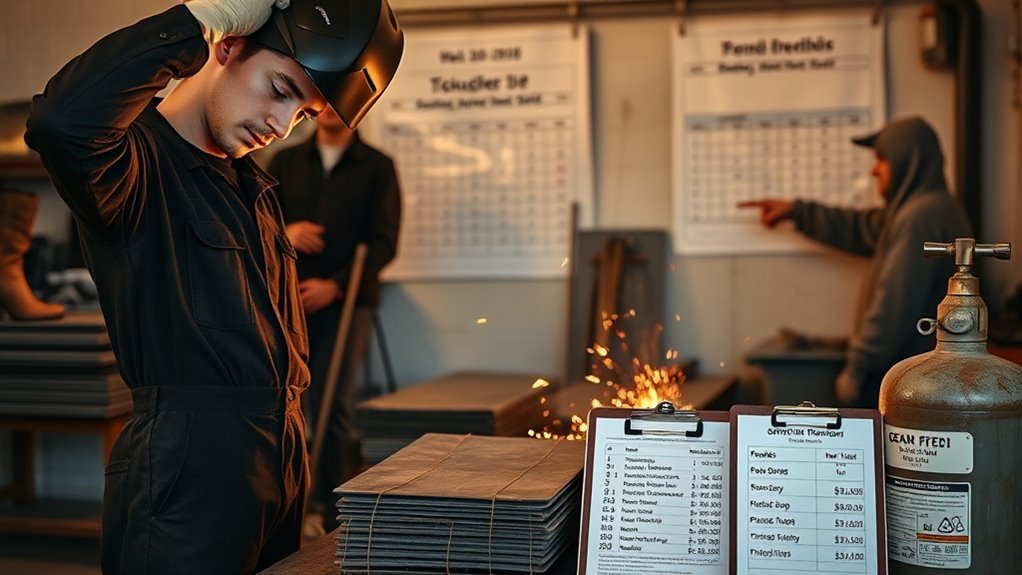You’ll typically pay anywhere from a few hundred dollars for short 45–100 hour courses up to $6,000 for intensive 300‑hour programs, while multi‑semester certificates or diplomas at community colleges or technical schools run roughly $12,000–$20,000 total. Expect extra costs for tools, PPE, textbooks, exams and transportation ($100–$1,000+). Community colleges usually cost less and offer more aid; evaluate hours, credential outcomes and placement rates to judge value if you want more detail.
Tuition Ranges by Program Type and Length

While program length and format vary, you’ll typically pay anywhere from a few hundred dollars for individual courses to tens of thousands for multi-semester certificates: short certificate courses can start around $519 per class or reach about $6,000 for a 300-hour program;
Bucks County Community College charges $3,300 per 96-hour evening level (about $9,900 if you complete all three levels);
Delaware County Community College offers a 225-hour certificate with individual classes under $500;
and the Pennsylvania College of Technology lists a four-semester, 59-credit welding certificate at roughly $16,000 per year.
You should evaluate welding program types by duration and credential: single courses, stacked certificates, and multi-semester diplomas.
Tuition variability reflects contact hours, credit load, and institutional pricing.
Tuition varies because of differences in contact hours, credit load, and institutional pricing—compare per-hour and per-program costs.
Compare per-hour and per-program costs to choose the most cost-efficient path.
Typical Additional Costs to Budget For

Because tuition only covers classroom instruction, you should budget for several predictable extra costs when planning welding training in Pennsylvania.
For a clear cost breakdown, plan for personal safety equipment and basic tools (~$188) plus specialized welding supplies that vary by course.
Add textbooks and online resources, typically $100–$300. Factor certification exam fees, which can add several hundred dollars to your total.
Don’t forget transportation: gas, transit fares, or parking can materially affect monthly expenses if you commute.
Budgeting tips: create a spreadsheet with line items (materials, exams, books, transport) and estimate high and low scenarios.
Research program-specific requirements early so your cost breakdown reflects actual mandatory expenses, not surprises.
Financial Aid, Scholarships, and Payment Plans

If you need help covering training costs, Pennsylvania welding programs offer multiple aid paths you can tap into: payment plans (a common example is a 300‑hour program priced around $6,000 with a 34% down payment and two monthly installments), institutional scholarships (some schools award $1,000 to qualifying high‑school seniors), federal/state grants and loans for eligible students, veteran‑specific assistance, and third‑party employer contracts.
You can pursue scholarship opportunities through schools, local foundations, and trade associations; awards often target entry candidates and can cut program costs materially.
Payment assistance commonly appears as installment plans or institutional grants; community-college classes under $500 let you target skill gaps affordably.
Verify eligibility, application deadlines, and employer contract terms to maximize aid and minimize out-of-pocket expense.
Cost Comparison: Community Colleges vs. Trade Schools

When you compare tuition per program, community colleges often charge lower per-hour rates (e.g., $519 for a 45-hour course) while some trade schools list higher flat tuition for extensive programs.
Factor in additional fees and program length—community college certificates may add course fees or per-credit costs, whereas trade schools can bundle materials and lab fees into a single price.
Also weigh financial aid options: community colleges generally offer more scholarships and payment plans that can cut your net cost compared with many trade schools.
Tuition per Program
Many Pennsylvania welders-in-training will find community colleges deliver lower per-program tuition than trade schools, with examples like a 225‑hour certificate at roughly $6,000 and individual classes under $500, versus some trade and specialty programs that stretch from about $3,300 for shorter 96‑hour courses to extensive 900‑hour offerings backed by financial assistance.
For your tuition breakdown, expect community colleges (e.g., Community College of Philadelphia) to price 300‑hour tracks near $6,000 with payment plans, while trade schools may offer compact, entry-level courses around $3,300.
Specialized schools can push hours—and total costs—higher but often pair programs with grants or loans.
Use program comparisons to match hours, credential outcomes, and available financial support to your timeline and budget.
Additional Fees
Across Pennsylvania programs you’ll pay more than base tuition: expect community colleges‘ short-cert courses to start around $519 and full 300‑hour tracks near $6,000, while trade-school offerings often sit higher (about $3,300 for 96‑hour courses) and tack on materials and equipment fees—typically about $188 for personal safety gear and basic tools.
You’ll need to budget beyond tuition for equipment costs and safety gear. Community colleges usually keep materials fees lower; trade schools charge more for intensive hands-on labs and consumables.
Compare fee breakdowns: some list tools, consumables, certification exam costs separately. Know what’s included before you enroll.
- Anticipation: unexpected fees can erode your budget fast.
- Frustration: vague fee schedules cause last-minute expenses.
- Confidence: clear line-item costs let you plan accurately.
Financial Aid Options
Beyond tallying tuition and materials, you’ll want to compare how community colleges and trade schools help cover costs through financial aid.
You’ll find community colleges (e.g., Delaware County CC’s ~$6,000 certificate; individual classes < $500) and trade schools (e.g., Bucks County’s $3,300 for 96 hours + $188 materials) both promote financial assistance programs and scholarship opportunities.
Schools list grants, institutional scholarships, and targeted aid for high school seniors and veterans. Community College of Philadelphia adds a structured payment plan for its 300‑hour course: 34% down, then two monthly installments, which reduces upfront burden.
When evaluating cost, quantify net price after grants/scholarships, verify eligibility for veteran or senior aid, and compare payment-plan terms to determine true affordability.
Return on Investment and Expected Salaries in PA

If you’re weighing the cost of training against career prospects in Pennsylvania, welding programs typically pay off quickly: the state’s average welder salary is about $48,770 and can rise considerably with specialized skills and experience.
You’ll evaluate salary expectations and investment benefits when deciding on a program: entry-level roles like Brazer, Fabrication Welder, and Industrial Welder are in demand and often start near that average.
Program costs range roughly $3,300 to $6,000 for full training, and job growth in PA is projected at 7% (2020–2030), supporting long-term placement.
- Pride — knowing your training converts to stable income and marketable skills.
- Relief — costs recouped quickly via starting wages and overtime.
- Confidence — advancement and specialty pay boost lifetime earnings.
How to Choose an Affordable Welding Program
When choosing an affordable welding program, compare total tuition and fees across options—from single courses around $519 to full 300‑hour programs near $6,000—to see what fits your budget.
Check scholarships, grants, and payment plans that can reduce out‑of‑pocket costs and factor those into your net price.
Finally, weigh program length against value: shorter, cheaper courses may save money now but longer programs with hands‑on training often deliver higher entry wages (PA average ~$48,770) and better ROI.
Tuition and Fees
Start by totaling what you’ll actually pay: tuition, mandatory fees, materials and safety gear, and any financing charges.
You need a clear tuition breakdown and to compare fee structures across schools. A 300-hour extensive program can run about $6,000, often with a 34% down payment plus two monthly installments.
Short courses (45-hour or GMAW/TIG classes) are commonly ~$519 each. Factor in roughly $188 for personal safety tools where listed.
Don’t assume sticker price covers consumables or retakes.
- Fear: unexpected fees can nullify perceived bargains.
- Hope: transparent breakdowns let you plan and negotiate payment terms.
- Confidence: data-driven comparisons show true cost per training hour and value.
Financial Aid Options
You’ve already broken down tuition, fees, materials and payment schedules — now look at financial aid to lower your actual out‑of‑pocket cost. Compare programs ($500–$6,000) and confirm financial aid eligibility early — grants, loans, and scholarship opportunities can cut cost materially. Ask schools about program-specific scholarships (e.g., $1,000 for high‑school seniors) and about payment-plan terms (common: 34% down + monthly installments).
| Aid type | Typical impact |
|---|---|
| Grants | Reduce billed balance; need FAFSA or school form |
| Scholarships | One‑time awards; competitive; check deadlines |
Document requirements, deadlines, and institution reputation. Quantify net price after aid for apples‑to‑apples comparisons and prioritize programs with clear, documented aid offers.
Program Length vs. Value
Although a shorter certificate might cost as little as $519 and a full 300‑hour course runs up to $6,000, you should weigh hours-to-skills and credential outcomes to judge true value.
You’ll compare program duration against measurable educational outcomes: skills acquired, certification readiness, and job placement rates. Short programs (e.g., 225-hour certificates) cut cost and time but may limit advanced techniques; longer pathways let you stack credits toward a degree and improve hiring prospects.
Check schools’ placement data and available financial aid to lower net price.
- Fear: pick a cheap program and miss required certifications.
- Hope: extend duration to gain higher wage skills and advancement.
- Confidence: choose programs with clear outcomes and placement metrics.
Frequently Asked Questions
Are Certification Exam Fees Included in Program Tuition?
Generally no — you’ll often pay certification costs separately; tuition inclusions usually cover training, materials, and lab access. Confirm program details and exam fee policies, request a breakdown, and budget for separate certification exam expenses.
Do Employers Reimburse Welding Training Costs?
Yes—you’ll often get employer incentives to cover tuition or exams, especially with training agreements tying repayment or retention. Data shows many firms reimburse partially or fully for certified welders, boosting workforce skill and retention metrics.
Can Veterans Use GI Bill for Welding School Here?
You can—think of GI Bill Benefits as a bridge to skills; you’ll access tuition, housing, and Veteran Support for accredited welding programs, provided the school’s VA-approved and your entitlement covers costs, with precise rates varying by program.
Are Evening or Weekend Classes Priced Differently?
Yes — you’ll often see class schedules affecting pricing differences; evening or weekend cohorts can cost more due to instructor overtime, facility hours, or lower enrollment, so compare per-hour and total tuition figures across programs.
Is Tool Allowance Ever Provided by Schools?
Yes — some schools cover tool procurement partially or fully through school funding, grants, or employer partnerships; you’ll find varied policies, so request itemized tool lists and funding eligibility data to compare actual out-of-pocket tool costs.
Conclusion
You’ve seen tuition ranges, hidden fees, aid options and salary outcomes — now picture standing at a glowing weld table, sparks splitting the air. Before you step in, weigh program length against total cost, compare community college vs. trade school ROI, and lock in scholarships or payment plans to shrink debt. Choose the option that matches certified credentials and projected PA wages, then start: that first spark could pay back faster than you think.


